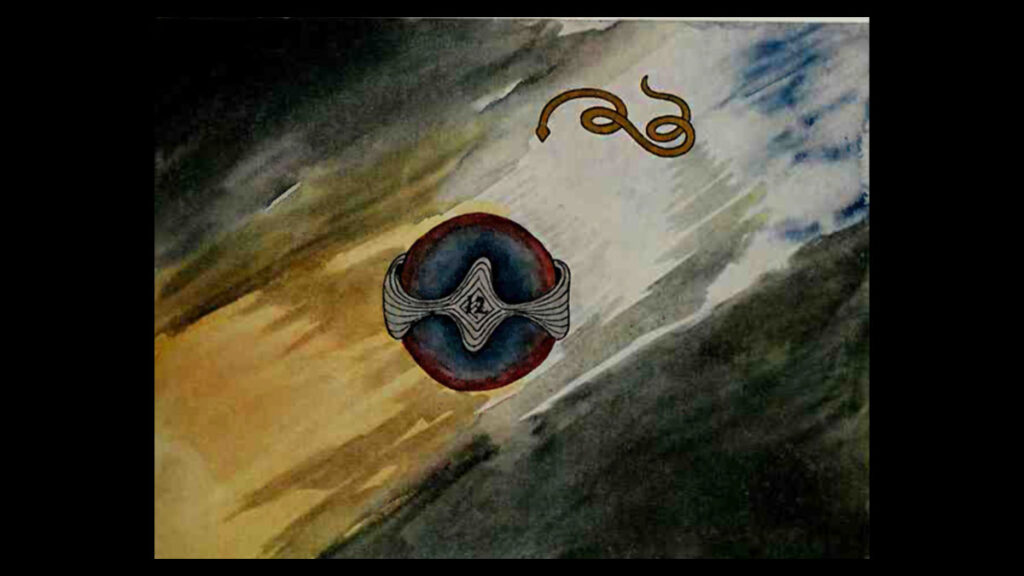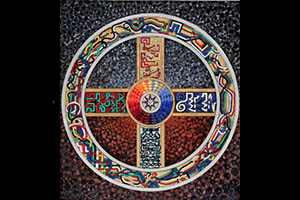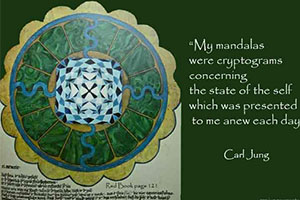
One can only conclude that the unconscious tends to regard spirit and matter not merely as equivalent but as actually identical, and this in flagrant contrast to the intellectual one-sidedness of consciousness, which would sometimes like to spiritualize matter and at other times to materialize spirit. That the lapis or in our case the floating sphere, has a double meaning is clear from the circumstance that it is characterized by two symbolical colours: red means blood and affectivity, the physiological reaction that joins spirit to body, and blue means the spiritual process.
Archetypes of the Collective Unconscious

A Study in the Process of Individuation
Drawing 3
The third picture, done as spontaneously as the first two, is distinguished most of all by its light colours. Free-floating in space, among clouds, is a dark blue sphere with a wine-red border. Round the middle runs a wavy silver band, which keeps the sphere balanced by “equal and opposite forces,” as the patient explained. To the right, above the sphere, floats a snake with golden rings, its head pointing at the sphere-an obvious development of the golden lightning in Picture 2. But she drew the snake in afterwards, on account of certain “reflections.” The whole is “a planet in the making.” In the middle of the silver band is the number 12. The band was thought of as being in rapid vibratory motion; hence the wave motif. It is like a vibrating belt that keeps the sphere afloat. Miss X compared it to the ring of Saturn. But unlike this, which is composed of disintegrated satellites, her ring was the origin of future moons such as Jupiter possesses. The black lines in the silver band she called “lines of force”; they were meant lo indicate that it was in motion. As if asking a question, I made the remark: “Then it is the vibrations of the band that keep the sphere floating?” “Naturally,” she said, “they are the wings of Mercury, the messenger of the gods. The silver is quicksilver!” She went on at once: Mercury, that is Hermes, is the Nous, the mind or reason, and that is the animus, who is here outside instead of inside. He is like a veil that hides the true personality.” We shall leave this latter remark alone for the moment and turn first to the wider context, which, unlike that of the two previous pictures, is especially rich….
The context to Picture 3 here established needs a little commentary. First, it must be emphasized that the patient felt the moment of painting this picture as the “climax” of her life and also described it as such. Second, two “big” dreams have amalgamated in the picture, which heightens its significance still more. The sphere blasted from the rock in Picture 2 has now, in the brighter atmosphere, floated up to heaven. The nocturnal darkness of the earth has vanished. The increase of light indicates conscious realization: the liberation has become a fact that is integrated into consciousness.
The patient has understood that the floating sphere symbolizes the “true personality.” At present, however, it is not quite clear how she understands the relation of the ego to the “true personality.” The term chosen by her coincides in a remarkable way with the Chinese chen-yen, the “true” or “complete” man, who has the closest affinity with the homo quadratus of alchemy; As we pointed out in the analysis of Picture 2, the rotundum of alchemy is identical with Mercurius, the “round and square.” In Picture 3 the connection is shown concretely through the mediating idea of the wings of Mercury, who, it is evident, has entered the picture in his Own right and not because of any non-existent knowledge of Bohme’s writings.
For the alchemists the process of individuation represented by the opus was an analogy of the creation of the world, and the opus itself an analogy of God’s work of creation. Man was seen as a microcosm, a complete equivalent of the world in miniature. In our picture, we see what it is in man that co responds to the cosmos, and what kind of evolutionary process is compared with the creation of the world and the heavenly bodies: it is the birth of the self, the latter appearing as a microcosm. It is not the empirical man that forms the “correspondentia” to the world, as the medievalists thought, but rather the indescribable totality of the psychic or spiritual man, who cannot be described because he is compounded of consciousness as well as of the indeterminable extent of the unconscious. The term microcosm proves the existence of a common intuition (also present in my patient) that the “total” man is as big as the world, like an Anthropos. The cosmic analogy had already appeared in the much earlier dream under narcosis, which likewise contained the problem of personality: the nodes of the vibrations were great personalities of historical importance.
In our picture Mercurius forms a world-encircling band, usually represented by a snake. Mercurius is a serpent or dragon in alchemy (“serpens mercurialis”). Oddly enough, this serpent is some distance away from the sphere and is aiming down at it, as if to strike. The sphere, we are told, is kept afloat by equal and opposite forces, represented by the quicksilver or somehow connected with it. According to the old view, Mercurius is duplex, i.e., he is himself an antithesis. Mercurius or Hermes is a magician and god of magicians. As Hermes Trismegistus he is the patriarch of alchemy. His magician’s wand, the caduceus, is entwined by two snakes. The same attribute distinguishes Asklepios, the god of physicians. The archetype of these ideas was projected on to me by the patient before ever the analysis had begun.
The primordial image underlying the sphere girdled with quicksilver is probably that of the world egg encoiled by a snake. But in our case the snake symbol of Mercurius is re placed by a sort of pseudo-physicistic notion of a field of vibrating molecules of quicksilver. This looks like an intellectual disguising of the true situation, that the self, or its symbol, is entwined by the mercurial serpent. As the patient remarked more or less correctly, the “true personality” is veiled by it. This, presumably, would then be something like an Eve in the coils of the paradisal serpent. In order to avoid giving this appearance, Mercurius has obligingly split into his two forms, according to the old-established pattern: the mercurius crudus or vulgi (crude or ordinary quicksilver), and the Mercurius Philosophorum (the spiritus mercurialis or the spirit Mercurius, Hermes-Nous), who hovers in the sky as the golden lightning-snake or Nous Serpent, at present inactive. In the vibrations of the quicksilver band we may discern a certain tremulous excitement, just as the suspension expresses tense expectation: “Hover and haver suspended in pain!” For the alchemists quicksilver meant the concrete, material manifestation of the spirit Mercurius, as the above-mentioned mandala in the scholia to the Tractatus aureus shows: the central point is Mercurius, and the square is Mercurius divided into the four elements. He is the anima mundi, the innermost point and at the same time the encompasser of the world, like the atman in the Upanishads. And just as quicksilver is a materialization of Mercurius, so the gold is a materialization of the sun in the earth.
A circumstance that never ceases to astonish one is this: that at all times and in all places alchemy brought its conception of the lapis or its minera (raw material) together with the idea of the homo altus or maximus, that is, with the Anthropos. Equally, one must stand amazed at the fact that here too the conception of the dark round stone blasted out of the rock should represent such an abstract idea as the psychic totality of man. The earth and in particular the heavy cold stone is the epitome of materiality, and so is the metallic quicksilver which, the patient thought, meant the animus (mind, nous). We would expect pneumatic symbols for the idea of the self and the animus, images of air, breath, wind. The ancient formula– the stone that is no stone — expresses this dilemma: we are dealing with a complexio opposilorum, with something like the nature of light, which under some conditions behaves like particles and under others like waves, and is obviously in its essence both at once. Something of this kind must be con jectured with regard to these paradoxical and hardly explicable statements of the unconscious. They are not inventions of any conscious mind, but are spontaneous manifestations of a psyche not controlled by consciousness and obviously possessing all the freedom it wants to express views that take no account of our conscious intentions. The duplicity of Mercurius, his simultaneously metallic and pneumatic nature, is a parallel the symbolization of an extremely spiritual idea like the Anthropos by a corporeal, indeed metallic, substance (gold). One can only conclude that the unconscious tends to regard spirit and matter not merely as equivalent but as actually identical, and this in flagrant contrast to the intellectual one-sidedness of consciousness, which would sometimes like to spiritualize matter and at other tin1es to materialize spirit. That the lapis or in our case the floating sphere, has a double meaning is clear from the circumstance that it is characterized by two symbolical colours: red means blood and affectivity, the physiological reaction that joins spirit to body, and blue means the spiritual process (mind).
Archetypes of the Collective Unconscious
A Study in the Process of Individuation
Paragraphs 545-555




One Comment